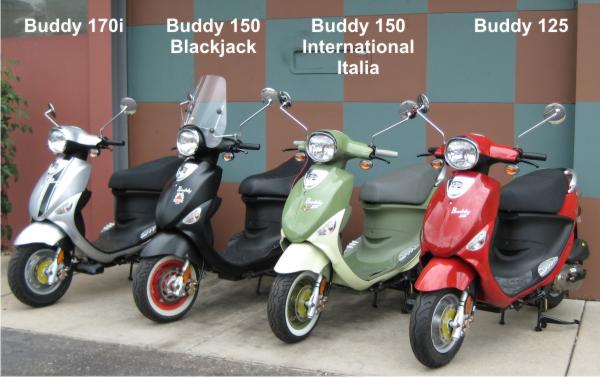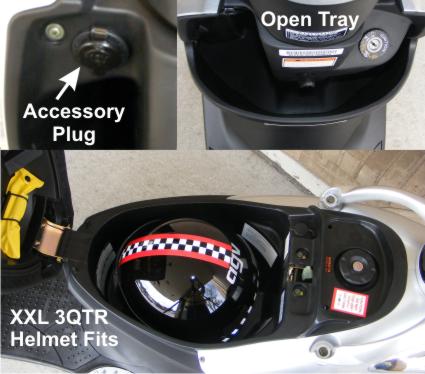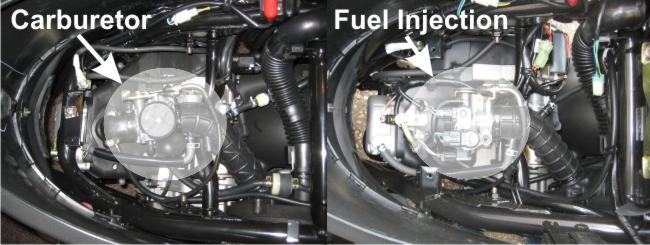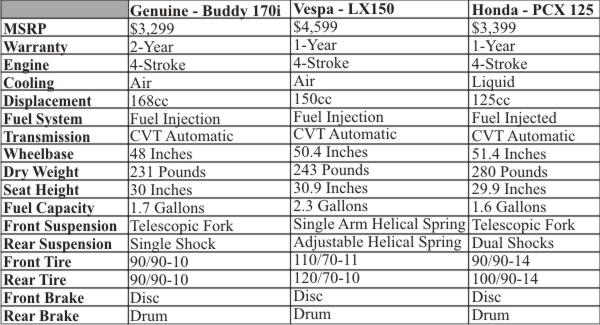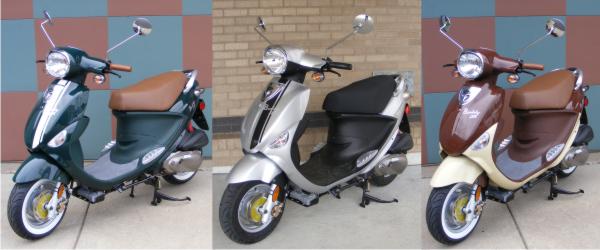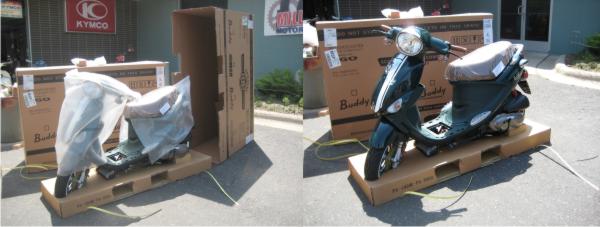 August, 2011
August, 2011
Ask anybody who owns one, the Genuine Buddy is (probably) the most popular scooter in the country. There is a rabidly enthusiastic owners group (www.modernbuddy.com) and the Buddy is cropping up in popular media all over the place. It’s cute, it works very well, there are lots of available accessories and it’s well supported. Like any good product line, the Buddy has evolved over the years. Introduced in 2006 in a 50cc 2-stroke version as well as a 125cc 4-stroke, the very next year saw evolution in the form of a larger, brighter headlight. The 50cc 2-stroke version has remained in the line up and a 150cc 4-stroke had been added in the forms of the Buddy International and the performance oriented Buddy Blackjack. This year Genuine brings us the Buddy 170i with a 168cc 4-stroke oil-cooled fuel injected power plant. The picture below shows the four iterations of the 4-stroke Buddy, the solid color 125cc, the International 2-tone 150cc, the flat black performance 150cc Blackjack and now the new 170i. Both 150cc Buddy models are limited to what is currently available. At this point, the 170i will replace the 150cc versions. All the Buddy models are built by PGO of Taiwan for Genuine.
We’ve wanted to review one for months, but getting a Buddy 170i turned out to be tougher than one might expect. They have been VERY popular with customers and Scooterville, our usual source for Genuine Scooters, was sold out. Fate intervened in the form of Cari from St. Paul who had just purchased a silver Buddy 170i and very graciously allowed us to borrow it for this review. Thanks a bunch Cari.
Speedometer Reading/Speed/Fuel Economy
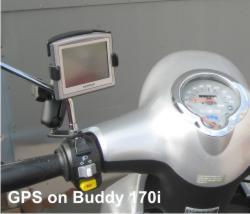
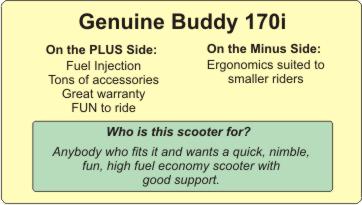
Fuel economy was very good. Again, this scooter isn’t broken in yet and I got 87.5 MPG on hard riding including some higher speed runs. I also did a “parkway” run – minimal starts and stops and consistent lower speeds of about 35 MPH maximum and saw 92 MPG. That’s with my robust (220 pounds) figure on a scooter that should only improve as it breaks in (the scooter, not my robust figure).
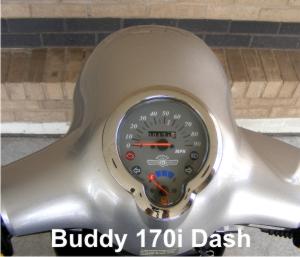
One of the reasons for the popularity of the Buddy scooters is their well thought out features. The speedometer cluster gives you the basics in an easy to view at-a-glance pod that also integrates well into the design of the scooter. Speed is indicated in miles per hour. There is an engine light and left turn signal indicator on the left side and a high beam and right turn signal indicator on the right side. Below is a fuel gauge. No tachometer, or clock, or other “extras”. The main switch has three positions with one performing two functions. There is an “off” position, an “on” position just to the right and a “lock” position to the left that can be actuated with the steering turned to the left. Also pushing inward while turning to the left actuates the seat release. There is a small but handy tray with a power socket to the left. I used it to power my GPS because I had neglected to fully charge the battery before I started testing – worked just fine.
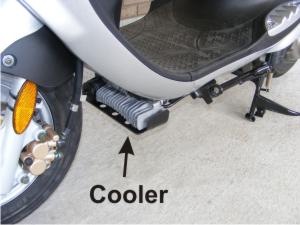
The main storage area is under the seat. I was able to get my three-quarter helmet in there easily and still close the seat. Fueling the Buddy 170i is accessed under the locking seat which means one’s gas cap is also (more or less) secured. The Buddy does not come from the factory equipped with a rear luggage rack. That’s a passenger grab rail that you see back there. Never fear, there are rear racks, topcases, metal “milk crates”, front baskets and front racks available from your Genuine dealer that are made for the Buddy.
The Buddy 170i is powered by an air/oil-cooled 4-stroke 168cc engine which is fed via fuel injection. Power gets to the rear wheel via a CVT (Continuously Variable Transmission). The front brake is a disc grabbed by a dual piston caliper, rear braking is handled by a drum. Starting is electric only, unlike the carbureted Buddy models, the 170i does not have a kick-start option.
For comparison, I selected the Vespa LX 150 and the Honda PCX125 because they are also fuel injected. The Honda SH150i is fuel injected and closer to the Buddy in displacement, but it’s a big-wheeled scooter and I felt that the PCX is closer to the intended use and market of the Buddy. The Buddy has the shortest wheelbase, the lightest weight, lowest price, and best warranty.
With the added feature of fuel injection, I consider the Buddy 170i MSRP of $3,299 to be a very good deal. The Buddy 150 International had an MSRP of $3,199 and it was carbureted. The addition of fuel injection involves much more than just replacing the fuel/air mixing unit. There needs to be a fuel pump, sensors, and increased electronic engine control…. WAY more than $100 worth.
With the added feature of fuel injection, I consider the Buddy 170i MSRP of $3,299 to be a very good deal. The Buddy 150 International had an MSRP of $3,199 and it was carbureted. The addition of fuel injection involves much more than just replacing the fuel/air mixing unit. There needs to be a fuel pump, sensors, and increased electronic engine control…. WAY more than $100 worth.
Riding Impressions
The Buddy 170i starts easily and quickly settles into a smooth idle. It was HOT and HUMID outside while I was riding this scooter and the Buddy did not stumble once. I’ve ridden ALL the Buddy 4-stroke versions a good bit and have owned (or still own) a 125 and a Blackjack. The Buddy 170i is smoother running and more responsive than either the 125 or the 150. It’s a touch quicker as well, but we’re not talking a huge difference. I attribute this to the fact that the Buddy 125 is likely the quickest scooter in its class to begin with. As displacement increases and fueling improves, there are gains but not quantum leaps.
Before I talk about the handling and braking of the 170i let me just say that I have been spoiled by the Buddy Blackjack. That scooter comes equipped with brakes and suspension that are class-leading and the Buddy 170i just isn’t to the same level. That’s NOT to say that the Buddy 170i isn’t a hard-braking-flickable-blast-to-ride… it is. It’s just not the insane machine that the Blackjack was (unless you can find a dealer with one, a new Blackjack is a thing of the past).
Riding on 10 inch tires with good suspension and braking, the Buddy 170i is nimble, responsive and easy to handle. The brakes are plenty strong enough for a scooter of this size. Acceleration from a stand-still up to about 50 MPH is surprisingly strong. It’s especially surprising to the cars around you who don’t expect a scooter to pull away from a stop like the Buddy 170i does. Roll-on acceleration from 20 MPH to 45 MPH is more fun than it should be. I found myself routinely zipping up to speeds rather above the posted limits on city streets just because it was such a good time. The note from the exhaust is pleasantly “rumbly” without being at all intrusive and I can’t think of anyone who would call it loud. At higher speeds (oh, say, 50 MPH and up) the Buddy 170i is “twitchy”. I wouldn’t call it exactly unstable, but those same 10 inch wheels that make the Buddy so much fun around town are definitely NOT the best choice for highway cruising. In fact, even though all the 4-stroke Buddy scooters have the engine performance for highway jaunts, the small wheels, short wheelbase and light weight don’t add up to a good highway machine.
The ergonomics of the Buddy 170i are ideal for “medium” people. I would say that from 5′ tall to 6′ tall you will find a comfortable position on a Buddy as long as you don’t have unusually long legs or large feet. The floorboard is relatively narrow and slightly curved. The reach to the handlebars is not too long or too short. The seat is formed with space for two people and there are passenger footrests (those silver-colored thing below the seat) but two-up riding is not what the Buddy does best. It’s certainly possible, especially with two small-to-medium sized people, but the Buddy excels as a one-person machine. The Buddy is a scooter that one sits “on” and not “in” which is part of what makes it feel so nimble. As long as it fits you, riding the Buddy 170i is fun. Everything about it speaks to having a good time on one’s scooter.
The Genuine Buddy 170i is currently available in three colors:
1.) green with a white stripe, brown seat & grips, and green interior plastic
2.) silver with a black stripe, seat, grips& interior
3.) brown/beige with brown seat, grips, interior and no stripe.
OK, that’s probably not completely true… the “available” part anyway. Check with your local Genuine dealer to see what they have in stock.
Fit and Finish
In the past several years, I’ve been lucky to have been able to “prep” quite a few scooters, often as part of our review process. The Genuine Buddy is on my “impressive” list so far as condition of scooters from the factory is concerned.
The Buddy is manufactured in Taiwan by PGO for Genuine. Good Taiwanese manufacturing is as good as anything from Japan or Europe and sometimes better. The components utilized in the Buddy are of good quality. The assembly of those components is also quite good. Look at the seams between panels, especially between “shiny” colored panels and flat plastic panels. Those seams will be tight and uniform. Look at the plastic chrome ring around the headlight. It will fit tightly and securely. Try all the switches and buttons. They will have positive engagement and feel solid. Take a few screws out and look at them. They will be of good quality and well finished. There is a kind of “joke” among some scooter dealers that the fasteners the Taiwanese utilize in their shipping material are better than the fasteners utilized by mainland Chinese manufacturers for their vehicles. Suffice to say that the fit and finish on the Genuine Buddy 170i is very good. Maybe just a notch below Honda which I consider to be the king of the hill for scooter fit and finish.
The color finish on the silver version of the Buddy 170i is exceptional. The pictures simply don’t do the “metal flake” silver justice. The green and 2-tone brown versions are also nice, but the silver really stands out.
Conclusion
At $3,299, the Genuine Buddy 170i is a great deal. Fuel injection is a very beneficial feature in any scooter and I expect we see more and more new scooters with fuel injection in the coming years. If you already have a Buddy 125, International 150 or Blackjack 150 should you rush out to upgrade? Hmmmm, probably not. If you’re like Bonegirl on ModernBuddy.com and you have 30,000 on your Buddy, by all means go for the new 170i. If you like a somewhat smaller, good-looking, well designed and well made scooter that is an absolute blast to ride you should head over to your local Genuine dealer right now. Better hurry, they may already be sold out of Buddy 170i scooters.
David Harrington

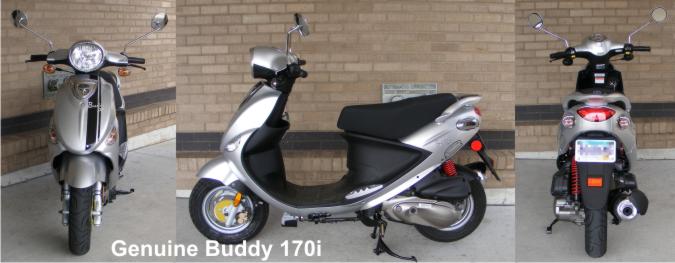
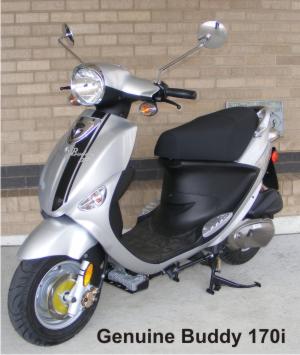 August, 201
August, 201